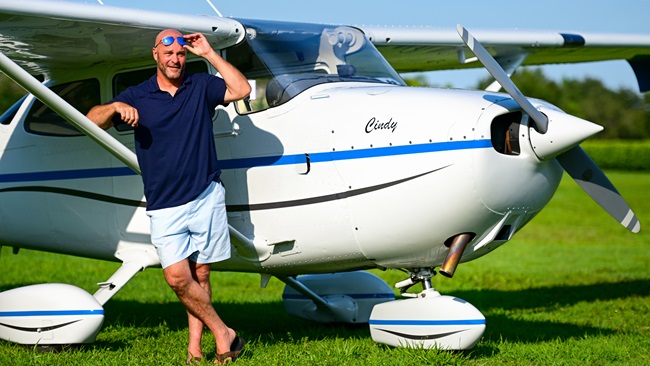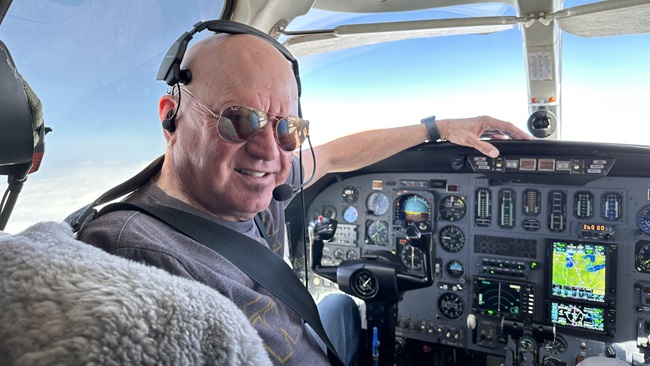Deep within a closet in my house there's a cardboard tube containing a rolled-up poster of Ohio Senator John Glenn. The good senator himself signed it in bold script. I stood in line at some long-forgotten function to meet Senator Glenn and get that poster — not because I like to collect images of elected officials, but because John Glenn was one of the original seven Mercury astronauts, and the first American to orbit Earth.
In my book, any airplane pilot with the guts to willingly lie recumbent on top of a rocket originally designed to launch warheads, not men, and ride it into space is a true hero. Unfortunately, the poster doesn't show Senator Glenn wearing that cool retro-look space suit issued to the first astronauts. I had to settle for one of him wearing a politician's suit.
I'm going to rummage through my closets for that poster and pin it up, because Senator John Glenn, who is still an airplane pilot and fellow AOPA member after all these years (he commutes between Ohio and Washington in his Beech Baron), is about to become a hero all over again.
The news is just out that Senator Glenn will be going back into space, this time as part of the crew aboard the shuttle Discovery. The launch is scheduled for October 29. His official function will be to serve as the subject in a study of the effects of space travel on an aging body. The fact that he will be 77 when they light the big torches attached to the Discovery makes him highly qualified for the job. Also, he's already passed the checkride — Date: February 20, 1962. Aircraft: Single-seat Friendship 7 capsule propelled on takeoff by Atlas rocket. Route: Three orbits of the earth at an altitude of about 845,000 feet and a speed of 17,500 mph. Flight time: 4 hours 55 minutes.
Astronaut Glenn epitomized the popular image of a space jock in the early 1960s — steel-jawed and tough-minded, a man you could count on in the heat of battle — or reentry. His terse, just-the-facts responses to questions from an insatiably curious public also was in character for a pioneering astronaut. Remarkably, 36 years later Glenn retains every bit of his aura of combat-pilot cool. This time around, however, Glenn's military bearing hasn't been able to mask his obvious glee over NASA's decision to send him back up.
The question is, why does Senator Glenn want to be an astronaut again? Why does he want to take another flight into space? Can't he be content to rest on the laurels of a spectacularly accomplished life that includes being a decorated combat pilot in two wars, a Navy and Marine Corps test pilot, achieving his astronaut feats, and winning an unprecedented four popular elections for a U.S. Senate seat from Ohio?
I don't think there's any big mystery behind his motivation. I'm willing to bet that for years the space-pilot side of Senator Glenn has been swept by the same emotions every pilot experiences when faced with the realization that there will be no more flying. The sense of loss must be especially acute if you've made just one trip into space, and a short one at that.
Ending your space flying after making three circuits around the globe is like making three touch and goes on your first solo flight in an airplane, and then never flying again. During that first flight you're consumed with the technical aspects of piloting the craft. There's no time to enjoy the beauty and wonder of the experience as it's happening — that comes on subsequent flights.
The cynics would say that in naming him to Discovery's crew, NASA bowed to Senator Glenn's political muscle and also saw an opportunity for a public relations stunt. I disagree. I think it's terrific that NASA is granting Glenn his longstanding wish to return to space. I'd love to be going in his place.
Back in the mid-1980s NASA had a wonderful program under way to send people from different walks of life into space. I requested an application for the journalist-in-space competition. Not that I stood a chance against heavy-hitter astronaut-wannabe journalists like Walter Cronkite, but the two of us never got the chance to square off. The January 28, 1986, catastrophic destruction of the Challenger, bearing the first teacher-in-space representative, Christa McAuliffe, stopped NASA's layman-in-space program cold.
In a way, Senator Glenn's upcoming flight is a return to that noble goal of opening up space to mere mortals. The adjective "mere" doesn't exactly describe Senator Glenn, but his role as a member of the Discovery crew is as much symbolism as it is science. A successful mission will say a lot about the viability of opening up space to a wider variety of people, physiologically speaking. Psychologically speaking, it could inject some welcome emotion into what has become a sometimes boringly technical event.
The dream of being able to fly in space may have lost some of the luster it had when John Glenn was waiting for the fuse to his Atlas rocket to be lit back in 1962, but it's still an inspiring dream. Most pilots I know would volunteer in a heartbeat to be an extra set of eyes aboard the space shuttle. Flying is flying, but flying the shuttle into space, around the earth, and then back onto a good ole conventional airplane runway — that's once-in-a-lifetime flying. Or twice, if you're Senator Glenn.
Godspeed, John Glenn.


